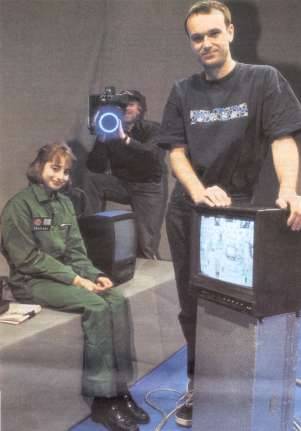Sub Zero Ariel 1999-02-16
SUB ZERO - ARTICLE FROM "ARIEL", 16th FEBRUARY 1999
It's Blind Man's Buff for the 21st century; it's a sophisticated computer game with humans, not digitally generated characters, centre stage; and it's all in the hands of young viewers who are just as likely to be sitting in front of PC screens as TV sets, anywhere in the country.
Sub Zero, the new interactive children's gameshow from CBBC, is pushing at several boundaries at once. It will make the fullest use so far of the BBC's virtual studio technology - developed in-house, but until now, exploited largely by programme-makers for one-off inserts. Using specially developed video conferencing software, it will also link up to internet cafes across the UK for a live knockout internet quiz.
Other contestants will remotely control robots on a studio floor, using the telephone keypads in their homes. And throughout the show, thanks to some brand new forum software, the audience can interact live, via the web, and see their contributions flashed up on the television screen as well as the CBBC Online site.
"CBBC are ahead of the game in understanding the quite sophisticated way that children use the internet. We've exploited that knowledge to create different gameshow elements, all of which could translate perfectly into truly interactive TV - this is a real glimpse of the future," says series producer Marc Goodchild.
The programme's online producer Mark Cossey concurs: "What's different about Sub Zero is that the TV and the internet are working together live as equal partners, not new media following old. That's a breakthrough."
In a way, the web came first. Contestants for a super-sleuth quiz called Net Detectives were recruited through a CBBC Online competition and even the show's chosen name was emailed to the site by 12 year old Edward Stevenson from Dorchester.
Likewise, the Sub Zero concept and the commission came first - the technology then had to come up with the creative solutions. "We were looking at different ways of staging a game in a darkened room, so we went to the virtual studio people to see what they could do for us," Goodchild explains. The result is a revolutionary adventure game in which a young studio contestant is guided "blind" around a virtual room by a phone contestant, the two collaborating to solve a series of real and virtual clues.
The reality is that the first child is filmed inside the empty, grey-sided Studio Zero, taking instructions down a phone line from his or her partner, who can see both the computer generated virtual set - a chintzy drawing room, bedecked with portraits of Children's BBC presenters - and the actual bare studio, inset into the TV screen. "It has to look believable - not like some of the early 2-D virtual effects," the producer stipulates.
And it does, thanks to the revolutionary camera-tracking technology (free-d), which allows normal camera mobility, and the new super-reflective material Truematte, which replaces the traditional chroma-key backdrop and can be lit with just six watts of blue light around the camera lens.
The actual set is an adaptation of one taken "off the shelf" from the virtual studio's small library of models - all built on silicon graphics workstations, using real time 3-D animation software, developed in-house. "It was appropriate and cost effective for this particular series," says Mike Jarvie, Virtual Reality Development manager. "Use of the studio for ongoing projects would obviously yield greater savings."
This first run of Sub Zero - in BBC Two's traditional experimental slot on Sunday mornings - is for six programmes. Further down the line, an entire gameshow could be built around the virtual set, Goodchild believes.
The series has been backed with funding from Smart Venture - the BBC-wide initiative to support new ways of working: "We're keen to get more programmes on air from the virtual studio and to encourage producers to take risks," explains executive producer David Allen. "This is a bold initiative, an ambitious series in many ways and a whole new genre that the BBC needs to get into."
In Mark Cossey's books, it's the "closest thing to live interactive on terrestrial TV. For that reason alone, I think people will be excited about it." More cross media collaborations are in the pipeline, he says. The virtual studio, meanwhile, has just been used to create a virtual art gallery for BBC Wale's new arts series The Big Picture and is being investigated by producers from Factual, Sport, News, Entertainment and Drama for future possibilities.
"It clearly has its limitations, but - with the right creative input - can be very flexible," Jarvie says. "A lot of producers approach us with: You might think this is a silly question... but this is brand new technology, and there is no such thing as a silly question. We're all learning as we go."
 Cross media quiz: producer Marc Goodchild briefs 12 year old contestant Zoe Solomon before her virtual challenge in the grey-walled studio Studio Zero, under the lens of cameraman Roger Bruce. Photograph John Green.
Cross media quiz: producer Marc Goodchild briefs 12 year old contestant Zoe Solomon before her virtual challenge in the grey-walled studio Studio Zero, under the lens of cameraman Roger Bruce. Photograph John Green.
